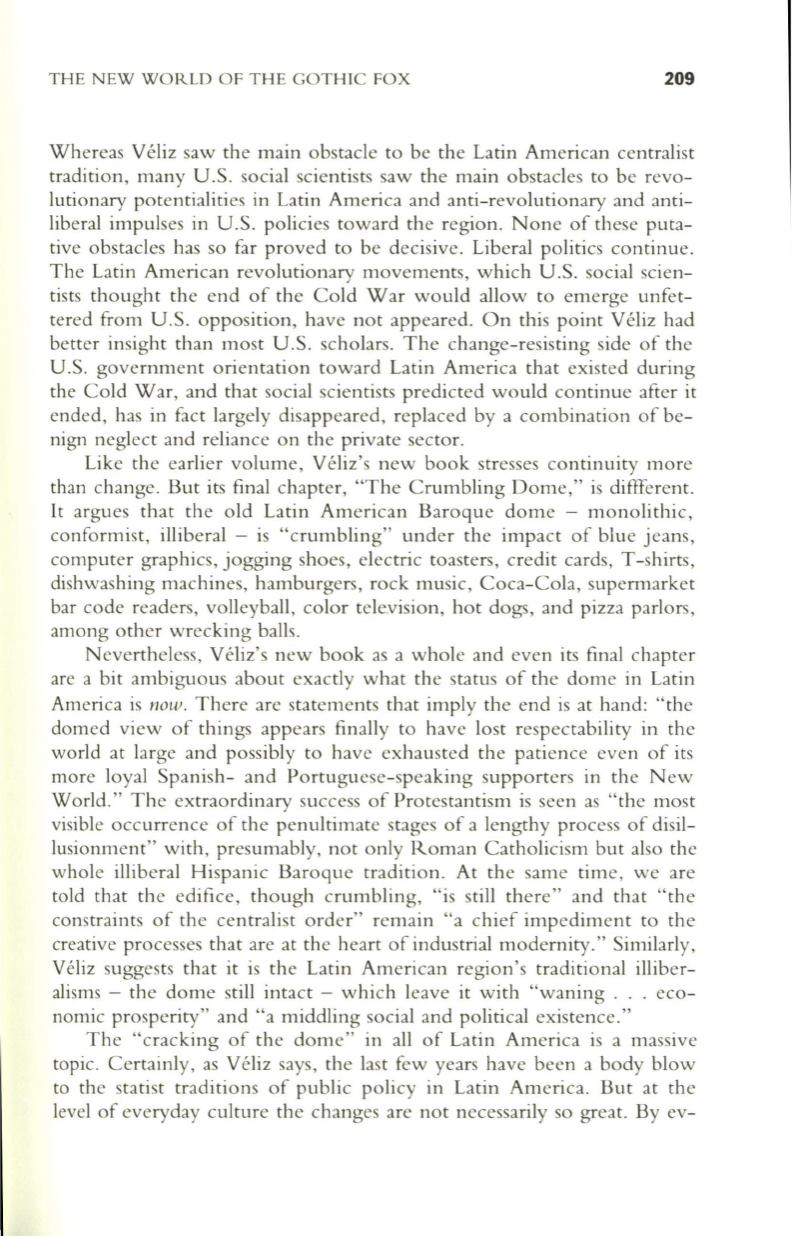
THE NEW WORLD OF THE GOTHIC FOX
209
Whereas Veliz saw the main obstacle to be the Latin American centralist
tradition, many U.S . social scientists saw the main obstacles to be revo–
lutionary potentialities in Latin America and anti-revolutionary and anti–
liberal impulses in U.S. policies toward the region. None of these puta–
tive obstacles has so far proved to be decisive. Liberal politics continue.
The Latin American revolutionary movements, which U.S. social scien–
tists thought the end of the Cold War would allow to emerge unfet–
tered from U.S. opposition, have not appeared. On this point Veliz had
better insight than most U.S. scholars. The change-resisting side of the
U.S. government orientation toward Latin America that existed during
the Cold War, and that social scientists predicted would continue after it
ended, has in fact largely disappeared, replaced by a combination of be–
nign neglect and reliance on the private sector.
Like the earlier volume, Veliz's new book stresses continuity more
than change. But its final chapter, "The Crumbling Dome," is diffferent.
It argues that the o ld Latin American Baroque dome - monolithic,
conformist, illiberal - is "crumbling" under the impact of blue jeans,
computer graphics, jogging shoes, electric toasters, credit cards, T-shirts,
dishwashing machines, hamburgers, rock music, Coca-Cola, supermarket
bar code readers, volleyball, color television, hot dogs, and pizza parlors,
among other wrecking balls.
Nevertheless, Veliz's new book as a whole and even its final chapter
are a bit ambiguous about exactly what the status of the dome in Latin
America is
now.
There are statements that imply the end is at hand: "the
domed view of things appears finally to have lost respectability in the
world at large and possibly to have exhausted the patience even of its
more loyal Spanish- and Portuguese-speaking supporters in the New
World." The extraordinary success of Protestantism is seen as "the most
visible occurrence of the penultimate stages of a lengthy process of disil–
lusionment" with, presumably, not only Roman Catholicism but also the
whole illiberal Hispanic Baroque tradition . At the same time, we are
told that the edifice, though crumbling, "is still there" and that "the
constraints of the centralist order" remain "a chief impediment to the
creative processes that are at the heart of industrial modernity." Similarly,
Veliz suggests that it is the Latin American region's traditional illiber–
alisms - the dome still intact - which leave it with "waning . . . eco–
nomic prosperity" and "a middling social and political existence."
The "cracking of the dome" in all of Latin America is a massive
topic. Certainly, as Veliz says, the last few years have been a body blow
to the statist traditions of public policy in Latin America. But at the
level of everyday culture the changes are not necessarily so great. By ev-


